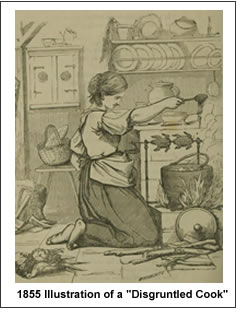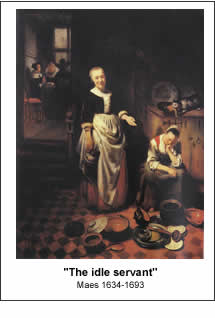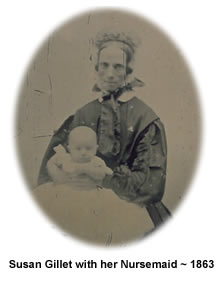When we think of servants and the places they might have worked, we tend to imagine large households employing many servants as seen in popular television serials, such as “Upstairs Downstairs” or in films such as “Gosford Park”.
In reality it was only a small percentage of the population who could afford to keep such large establishments and many of our servant ancestors would probably have worked in much smaller households. Having servants was normal to the upper classes, a sign of gentility for the middle classes and very useful to shopkeepers, artisans and publicans, who used them as extra labour in their businesses when needed.
Sources of employment
Domestic service was the second biggest employer in Britain after agricultural work in the 19th century. It employed mostly women and in many cases was the only option open to unskilled working class girls. They would usually go into service at about the age of ten or twelve but later on in the century, children as young as eight were leaving their homes for unfamiliar households. First jobs would often be found close to home with the local vicar or squire playing an important role in recommending a servant or a post. However, young people from the country were considered stronger and more wholesome than their town contemporaries and this, coupled with a desire to hire servants from other areas to avoid gossiping in the village, resulted in some servants being sent further away to work.

Other possible sources of employment were the local hiring fair and, later on in the 19th century, servant registries. Although some cooks and housemaids made use of the fairs, it was mostly dairy maids, holding their milking stools, who found work there along side the agricultural labourers. Servant registries, often run by women, continued to exist well into the 20th century. E.M Delafield in her fictional “Diary of a Provincial Lady” set in the 1930s mentions them
“Visited several Registry Offices, and am told that maids do not like the country – which I know already – and that the wages I am offering are low.”
By the time she is writing servants have become difficult to come by. Increased employment opportunities offered by factories and their more attractive working conditions, and no I’m not joking, had made going into service an unpopular career choice, but more of this later.
Newspapers were also full of advertisements from employers looking for servants and from servants looking for employers. Employers asked for girls who were “clean and active” and stipulated that, “no one need apply whose character will not bear the strictest investigation”.
Servants at their boldest might ask for a “respectable” or “regular family” but most were at pains to provide “3 years character” and to claim “no objection to town or country”. Perhaps the Provincial Lady should have been looking in the newspapers for her servants!
The workhouse also supplied maids but mostly to the lower middle classes and artisans. Servants from the workhouse, who had probably never seen, let alone touched, fine china and linens, were considered too clumsy to work in the more well off establishments. However, once a servant had gained experience, skills and a “good character,” there was nothing to stop them looking for a better position in another household and in fact some employers considered it their duty to help their newly trained servants move on. In general there was a high turn-over of servants. It’s very rare to find a servant employed in the same household from one census to the next. The reasons for this could be the servant moving onwards and upwards or a falling out with their employer, which made staying put difficult.
Maid of all work
Life at the bottom end of the servant ladder was not easy. The maid of all work, often the sole servant employed in a modest household, truly lived up to her name. Not only was she expected to do all the cleaning but also the cooking with limited help from her employer. Her daily routine puts any of us who complain about a bit of dusting and ironing to shame.

She was the first up in the morning and would start work in the kitchen by lighting the range and cleaning it while the fire got going. Then, after having put the kettle on to boil, she would move on to the breakfast room to clean the fireplace before lighting it. She would then clean the room and sweep the carpet. After that she moved on to the hall where she would wash the floor, polish the brass and whiten the front steps.
Next she would change into clean clothes to continue with her less dirty duties. She would lay the table and cook breakfast for the family. While the family ate their breakfast she would deal with the bedrooms, stripping the beds to air them and emptying the chamber pots. With the help of her employer she would then make the beds and dust all the rooms before returning to the scullery to clear away the breakfast things and do the washing up. Once the washing up was finished the drawing room needed dusting, the carpet sweeping and the mirror polishing, pausing only to answer the doorbell when it rang.
Depending on when the family ate their main meal she would either spend the morning cooking and the afternoon cleaning or vice versa. Laundry days added extra back breaking work to the daily schedule and also meant that in smaller houses with nowhere to hang out the washing that the kitchen became saturated with steam from dripping washing. All the rooms in the house would be given a general clean with one room a day selected for a “thorough” clean. This might give the impression that our ancestors were fanatical about cleanliness, but open fires created a lot of soot and dust that needed cleaning up daily.
After having cooked, served and tidied up after the evening meal, she would have to clean the kitchen again and then prepare the bedrooms for the family. Her last duties of the day would be to put out all the fires and lamps and to lock the front door. To do this she had to wait until all the family were in bed – meaning that her day, which had probably started at six in the morning, did not end before ten at night. It was only later on in the 19th century and in larger households that the servants had their own bedrooms, the lowly maid of all work at the end of her long day, would probably have had to roll out her bedding on the kitchen floor amongst the dripping laundry and soot from the range.
You’ll notice that there’s no mention in this timetable of when the maid herself was supposed to eat or to do her own washing. It was generally considered that the servant class was made of much stronger stuff than their employers and this amount of work was seen as completely normal. She would have been allowed one afternoon off a week, an afternoon that started after five o’clock, and then only if she had done all her day’s work beforehand. She wasn’t permitted to have any followers and her life must have been a very lonely one.
Larger households
In general as a household’s fortunes increased so did their number of servants.

A housemaid might be taken on to help the maid-of-all-work, or a nurse if the family had young children. These nurses were sometimes barely older than their charges; young girls of twelve or fourteen were considered suitable. Next would come a cook and, after these three were in place, would probably come the first male servant.
Male servants were a sign of a more than respectable income as it was necessary to purchase a licence to employ one. These licences came into being in 1777 and were not abolished until 1937. In addition hair powder, which was used by footmen and coachmen, was also taxed between 1786 and 1869. This first male servant would work in the house as a valet and also outside with the horses and carriage.
From then on each additional servant would have a more specialised role such as: a lady’s maid, a butler, a housekeeper or more scullery maids and a laundry-maid. Footmen, because of their expensive livery and their relatively light duties, were perhaps the most ostentatious sign of wealth. It was important for them to be tall and have shapely turned calves, in fact the taller they were the more they were paid. Having a matching pair of footmen, of the same height and build, was sure to turn your acquaintances green with envy.
In larger households employing many servants a strict hierarchy operated. First of all there was the distinction between upper and lower servants. The upper servants, steward (on large country estates), butler, housekeeper, cook, lady’s maid or valet had the most contact with the family and did not wear livery. The lower servants, footmen, parlour maids, kitchen maids, under cooks etc were expected to show deference to them addressing the butler as ‘Sir”, the cook and housekeeper as “Mrs” and the ladies’ maids as “Miss”. When servants from visiting households arrived they were known by the surname of their employer.
Life below stairs in a large country house must have been less lonely than that of the poor solitary maid-of-all-work, but the servants were still constrained by the same rules. They were not permitted followers either and attachments between servants were frowned upon and could result in the dismissal of one of the couple. They had little free time and were expected to always be deferential to their employers and to know their place. In “Wives and Daughters” the new Mrs Gibson takes a very hard line against an old family servant:
“My dear girl, I should never have thought of sending an old servant away…She might have stayed forever for me, if she had only attended to all my wishes…But, you see she complained; and when your dear Papa spoke to her, she gave warning; and it is quite against my principles ever to take an apology from a servant who has given warning.”
Many employers viewed their servants as children who needed to be kept under close supervision. It was accepted that if a servant could tell tales about his or her employers or steal from them, they would. Everything that the servants needed such as candles and soaps were kept under lock and key and only given out by the mistress of the house. She was also advised to keep a close eye on the leftovers to make sure that the servants weren’t helping themselves to too much food and that the cook wasn’t wasteful in her food preparation.
Death knell for domestic servants
It is hardly surprising that, as conditions in the factories changed for the better and new opportunities opened up for girls in shops, domestic service gradually became unpopular.
A factory worker worked ten hours a day compared to the twelve hours of a housemaid. Factory workers had Sundays off and worked a shorter day on Saturday. For the housemaid Saturday was the same as every other day and the best they could hope for on a Sunday was a reduced workload. When they had a half-day they were expected to complete all their daily tasks before going out and on laundry days they were expected to get up even earlier than usual to fit in the extra work.
Factory workers also had greater freedom; they had the time and the opportunity to meet friends and to form attachments. Strangely enough they probably also got more fresh air than the average housemaid, who was confined to the house twelve hours a day and who spent most of that in a badly ventilated and ill-lit basement kitchen.
The two wars, women’s participation in war work and the introduction of labour saving devices into homes all helped to sound the death knell for domestic servants.
Georgette
© Georgette 2008
MOTHERING SUNDAY
We think of Mothering Sunday as a day to celebrate motherhood but, in fact, the origins of the day date back to the Middle Ages and have little to do with mothers. Throughout the year people worshipped at the nearest church to where they lived, their daughter church, but on the fourth Sunday in Lent it was usual for them to visit their mother church. The mother church was the largest church in the area often a cathedral.
Apprentices and servants, who worked away from home, would come back to be with their families at their mother church and it became a tradition for them to have this day off. With the different work commitments of the family it was probably the only day in the year when they could all get together. This Sunday was also a day when the normally strict Lenten fasting was temporarily lifted and simnel cakes would be baked to celebrate the family reunions.
Further Reading
The Victorian Domestic Servant – Trevor May
The Victorian House – Judith Flanders
